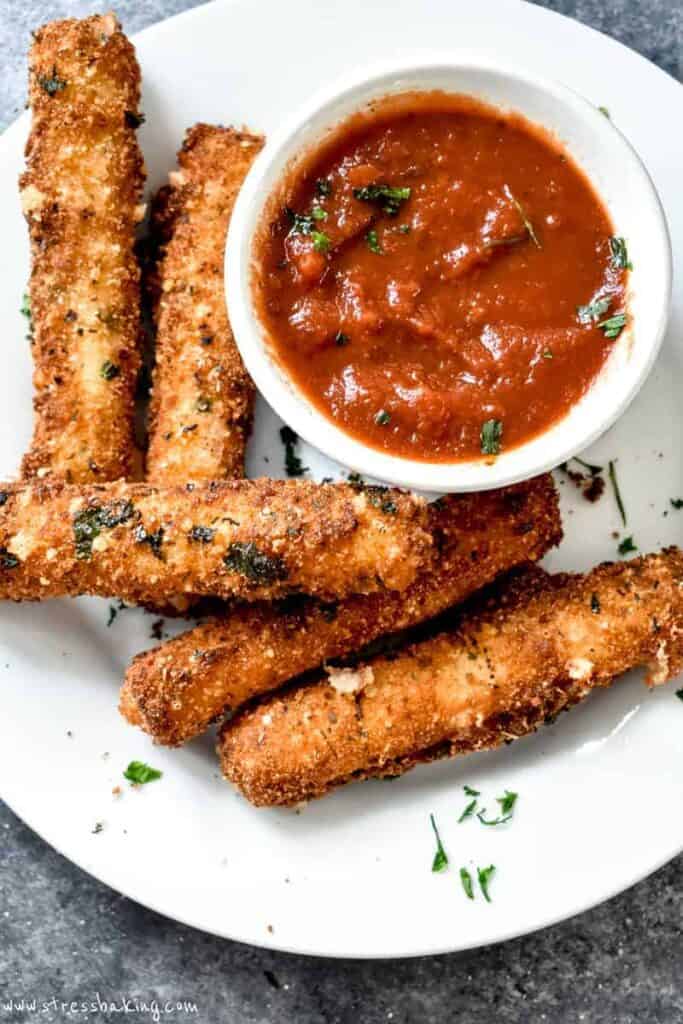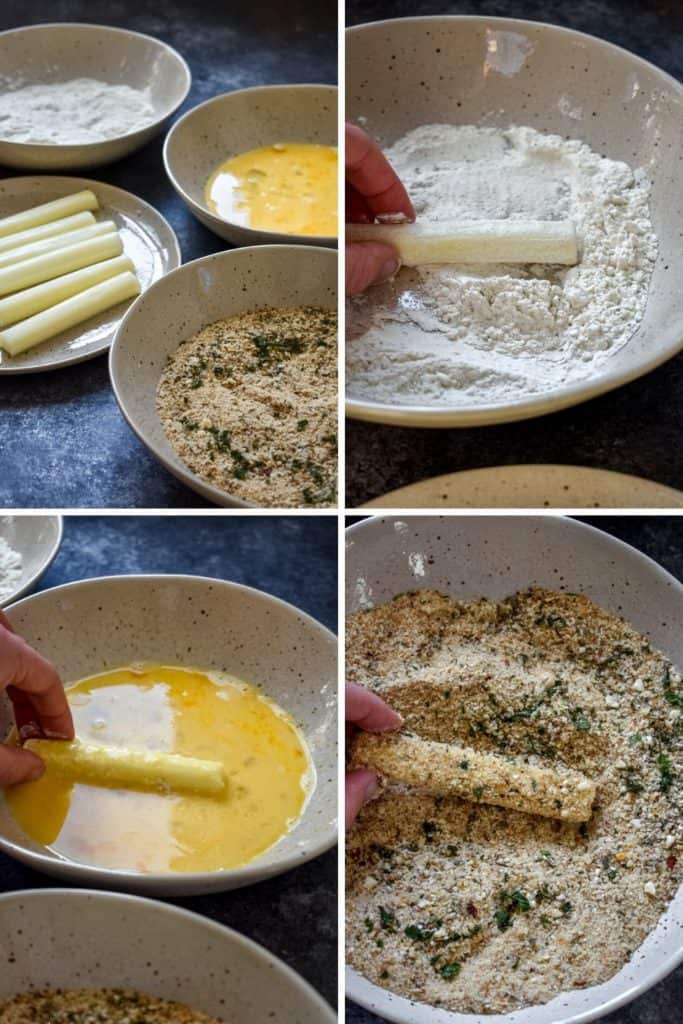How to Make Mozzarella Sticks Out of String Cheese


Homemade mozzarella sticks are easy to make! String cheese sticks are coated in batter and deep fried to golden, melted cheesy perfection. I've also included my favorite small batch marinara sauce recipe for dipping. Add these to your Super Bowl snack must haves!

Mozzarella sticks are one of those foods that I LOVE, but I always hate myself for ordering. It's literally a fried stick of cheese. But that's not why I hate myself it, because they're fricking delicious – it's because I have zero awareness of when I need to stop eating them.
If someone puts a plate of twelve mozzarella sticks down in front of me… I'm going to eat twelve mozzarella sticks.
I'm like the fish that grows to the size of its tank, but in this case it's my stomach that grows to accommodate the size of the pile of food.

Is that a good thing? No, of course not. But by no means do I do it all the time. Honestly, it might not even be once a year, it's so infrequent.
So when I do order mozzarella sticks… I make it count. Or in this case, when I make them at home and control exactly how many I make (read: consume with reckless abandon).
The Super Bowl is the perfect example of a time I allow myself to indulge in some of my favorites: these, soft pretzels, beer dip, bacon wrapped kielbasa, cheesy pizza pull apart bread.

Tips for making mozzarella sticks
Work with one cheese stick at a time. Speaking from experience, if you try to work on multiple sticks at once, it can be easy to lose track of which step you've done, and if you've done the second coating or not.
Be sure to coat the entire stick, all the way around. That includes each end! Any non-covered areas will leave openings to the cheese to melt out when you fry them.
Be gentle when you're handling the sticks during the coating process. If you're moving too quickly and grabbing them too firmly, you might accidentally slide some of the coating off of the cheese.
You'll notice we're coating each stick twice. This gives it enough of a breadcrumb coating that it reduces the chance that cheese will melt out the sides when you're frying them.

You have to freeze them before frying! For at least 1 hour. Absolutely, under no circumstance, and in no world, can you skip this step. If you don't freeze them and just skip right to frying them, they're going to disintegrate into a melty cheesy mess right before your eyes and you will be very, very sad. We're talking giant Disney character sad eyes kind of sad.
Hopefully this goes without saying, but don't save any leftover breadcrumb mixture for later use. You've been dredging a raw egg and flour covered piece of cheese through it… just toss it. It's okay.
You want the oil to be as close to 350°F as possible for best results. I always use my favorite ThermoWorks ChefAlarm to keep an eye on the temperature.
Be careful! Another thing that I hope goes without saying, but you're working with hot oil, so be careful when you're dropping the sticks in and removing them. Using long handled tongs and a gentle touch works well.

How to dispose of cooking oil
First things first, if you know you're going to do more frying soon – just save the oil to use again! Let the oil cool, then use a coffee filter or cheesecloth (aff link) to remove any crumbs, and store in an airtight glass container in a cool, dark place.
But if you're not saving it for another round, make sure to take the proper steps to discard the oil at home:
- Pack it and throw it away. Let the oil cool completely, then pour into a non-recycleable container with a lid and throw it in the trash. Examples would be milk cartons, takeout containers, or other plastic or wax-lined paper containers.
- Pour it in the trash – carefully and strategically. Once oil has cooled, slowly pour into the center of your trash can on top of absorbent items like paper towels, or discarded kitty litter. You don't want it to pool into the bottom of the bag, because that could go south.
- Freeze it and toss it. Pour cooled oil into an old can (think the kinds you'd have for black beans) and place in the freezer. Once it's solid, dump it into the trash.
How NOT to dispose of cooking oil
Don't ever do the following:
- Don't ever pour hot oil… anywhere. Always let it cool before you move forward with disposal.
- Don't pour it down the drain. Any drain. Not the kitchen sink, the toilet, nothin'. It could clog the pipes, and also make the water nearly impossible to be treated – potentially polluting local sewers.
- Don't pour it into compost piles. Fats are bad for compost, and oil is nothing but fat.

How to get rid of the smell of cooking oil
The fried food was delicious while you were eating it, but it's less than ideal when you can still smell the cooking oil odors the next day. Here are some ways you can eliminate the smell (or help prevent the lingering smell altogether):
- Ventilate! As soon as you start heating the oil for frying, turn on the hood vents. Weather permitting, open the windows, too. Air circulation is your friend.
- Line the area around your workstation with newspaper. It will catch the splatter and help make cleanup easier. But be careful it doesn't get too close to the stove flames!
- Clean up immediately. As soon as you're done cooking, dispose of the oil (see above tips), clean the pot you used and clean your stovetop and counters (and frankly, the wall behind the stove, too).
- Simmer some homemade potpourri on the stove. I like to fill a small pot with a couple cups of water, a few tablespoons of vinegar, and an assortment of spices and fruit peels and let it simmer until the water has evaporated to help eliminate the oil odors. I'm a big fan of orange and lemon peels with a cinnamon stick.
- When all else fails, bake! It feels like as good an excuse as any to make a batch of cookies or some banana bread. Your kitchen will smell great, and you'll have even more delicious treats.

As my friend Jim said about these fried sticks of heaven, "They have parsley on them. Which basically makes them a salad."
Obviously that's a joke… or is it?
After you've made this recipe, please consider coming back to share your experience with others by leaving a comment below with a star rating!

Easy Homemade Mozzarella Sticks
Homemade mozzarella sticks are easy to make! String cheese sticks are coated in batter and deep fried to golden, melted cheesy perfection. I've also included my favorite small batch marinara sauce recipe for dipping.
Prep Time 10 minutes
Cook Time 20 minutes
Total Time 1 hour 20 minutes
Servings 12 sticks and 1 cup sauce
Mozzarella Sticks
- 12 mozzarella string cheese sticks
- ⅓ cup all purpose flour
- ⅛ teaspoon salt
- ⅛ teaspoon ground black pepper
- 1 large egg
- 2 Tablespoons milk
- ¾ cup plain panko breadcrumbs
- 1 Tablespoon grated Parmesan
- ½ teaspoon dried basil*
- ½ teaspoon dried oregano*
- ½ teaspoon dried parsley*
- ½ teaspoon dried thyme*
- ½ teaspoon garlic powder*
- Pinch of crushed red pepper, optional
- Vegetable oil, for frying
- Marinara sauce, for dipping (see below for homemade recipe)
Easy Small Batch Marinara Sauce
- 1 tablespoon olive oil
- 1-2 cloves garlic, peeled and minced
- 8 ounces crushed tomatoes, 6 ounces or tomato sauce
- ¼ teaspoon dried basil
- ¼ teaspoon dried oregano
- Large pinch of salt
- Pinch of crushed red pepper
Mozzarella Sticks
-
Prepare a baking sheet with parchment paper and set aside.
In three separate shallow dishes, prepare the following:
-
Dish #1: Combine flour, salt and pepper and whisk to combine.
-
Dish #2: Combine eggs and milk and whisk to beat and combine.
-
Dish #3: Combine breadcrumbs, Parmesan, garlic powder, parsley, basil, oregano, thyme and red pepper flakes. Whisk to combine.
-
Working with one piece of cheese at a time, dredge each piece of string cheese in flour mixture, shake off excess. Dip in egg mixture, then coat in breadcrumb mixture and press to ensure it sticks.
-
Repeat this process again for each stick, then transfer to prepared baking sheet.
-
Transfer baking sheet to freezer and let freeze for at least 1 hour.
-
Fill a large pot with about 2" oil over medium heat until a thermometer inserted in the oil reaches 350°F.
-
Working in batches of no more than 4, carefully drop sticks into hot oil and turn occasionally until they are golden brown and crisp (about 2 minutes).
-
Transfer to a paper towel-lined plate, and sprinkle with a little salt if desired.
-
Serve immediately with your favorite dipping sauce (try my small batch marinara sauce recipe below) and enjoy!
Easy Small Batch Marinara Sauce
-
Heat oil in a small saucepan over medium-high heat, then add garlic and saute until fragrant, 1-2 minutes.
-
Add tomatoes, basil, oregano and salt. Reduce heat to medium-low and simmer, stirring occasionally for 10 minutes. Add red pepper (if using), stir and let simmer another 1 minutes.
-
Transfer to serving dish and serve immediately. Enjoy!
- Italian seasoning:If you don't have the individual spices (basil, oregano, parsley, thyme, garlic), you can substitute for 2 ½ teaspoons Italian seasoning mix.
- Mozzarella sticks are best served immediately after being fried, but they can be breaded up to 3 days ahead of time and kept frozen until ready to fry.
- Marinara sauce can be stored in a covered container in the fridge for up to 5 days.
- Note: Nutrition info is just for mozzarella sticks and does not include marinara sauce.
Calories: 134 kcal | Carbohydrates: 8 g | Protein: 8 g | Fat: 8 g | Saturated Fat: 4 g | Polyunsaturated Fat: 1 g | Monounsaturated Fat: 1 g | Trans Fat: 1 g | Cholesterol: 29 mg | Sodium: 345 mg | Potassium: 82 mg | Fiber: 1 g | Sugar: 1 g | Vitamin A: 76 IU | Vitamin C: 2 mg | Calcium: 48 mg | Iron: 1 mg
Course Appetizer
Cuisine Italian
Leave a comment and rating!
How to Make Mozzarella Sticks Out of String Cheese
Source: https://stressbaking.com/homemade-mozzarella-sticks/